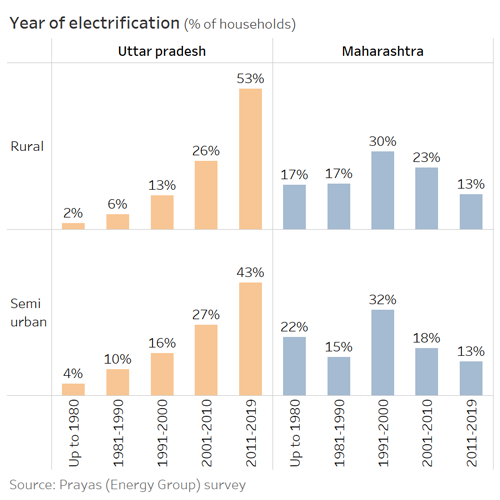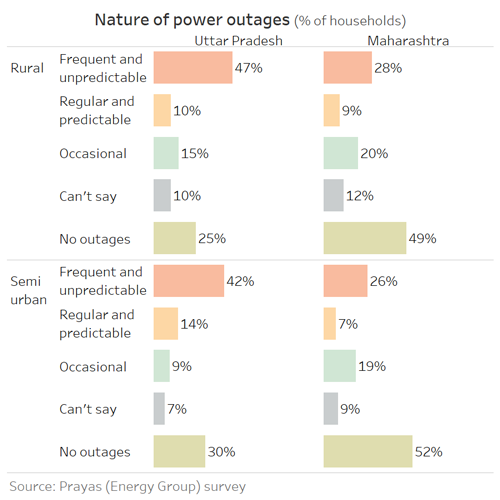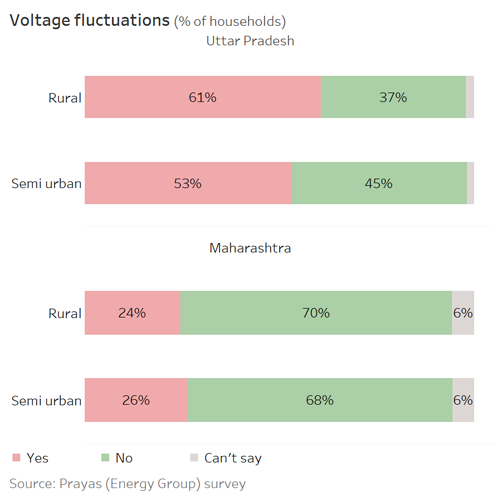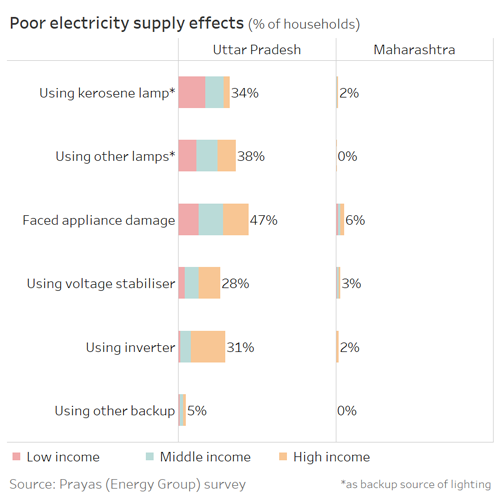Prayas (Energy Group) conducted a survey of 3000 households in semi-urban and rural areas of Uttar Pradesh and Maharashtra to understand their energy end-use patterns. This survey was conducted in February-March 2019. ECHO is a series of blog posts presenting the key findings of the survey. This post discusses perception of households on electricity supply quality and its impact on their electricity usage.
Sampling plan and household categorization are briefly described here.
Quality of Supply and Service (QoS) of electricity by the distribution companies (DISCOMs) has significant influence on a household’s use of appliances that can improve its standard of living. Inadequate electricity supply can limit the duration of use of appliances. Poor quality of electricity supply like frequent outages and voltage fluctuations can damage appliances or reduce their life. Some households invest in options like solar lamps, inverters, or voltage stabilisers. Others either restrict the use of appliances or avoid buying them altogether. Rural electrification programmes in India till date have succeeded in providing near-universal household access to electricity. The discourse is now shifting to providing reliable and quality supply as reflected in the Ministry of Power’s forthcoming draft distribution perspective plan to ensure round the clock power to all. This survey focuses on the perception of household related to electricity supply quality since it affects its decision on purchase and use of appliances. We have also been monitoring actual electricity supply quality at about 400 locations across India since 2015 under the Electricity Supply Monitoring Initiative (ESMI). The minute-wise data and analysis reports from all the locations is available publicly on www.watchyourpower.org. Our upcoming report will present a comprehensive analysis on the collected data.
Maharashtra has been early in providing near-universal household access to electricity while Uttar Pradesh joined the ranks only recently. As per the 2011 Census, about 84% of households in Maharashtra used electricity as a primary source of lighting while this share was only about 37% in Uttar Pradesh. The same is also reflected in our survey sample. The average year of electrification of our sample in Maharashtra is 1994 while that of Uttar Pradesh is about 2006. About 45% of the surveyed households in Uttar Pradesh have been electrified after 2011 (see Figure 1).

Figure 1: Year of electrification for surveyed households
Supply hours, the primary measure of QoS, reported by the surveyed households are observed to be higher in Maharashtra than Uttar Pradesh. The average daily supply hours are about 22 hours in Maharashtra and 15 hours in Uttar Pradesh with a significant variation within the sample (see Table 1). On an average, households in semi-urban area in Maharashtra get about 40 more minutes of electricity supply than their rural counterparts while the number is about 2 hours in Uttar Pradesh.
| Maharashtra | Uttar Pradesh | |
| Semi-urban | 23 ± 4 | 16 ± 5 |
| Rural | 22 ± 5 | 14 ± 5 |
| State | 22 ± 4 | 15 ± 5 |
Table 1: Average daily supply hours reported by surveyed households
The nature of power outages is as important as the total duration of power supply. Frequent interruptions can damage typical residential loads such as lighting and motors with increasingly electronic components. About 42-47% of households in Uttar Pradesh reported power outages to be frequent and unpredictable while the number is lower in Maharashtra at about 26-28% (see Figure 2). The unpredictable nature of power outages makes it difficult for households to confidently plan the use of appliances.

Figure 2: Nature of outages as perceived by surveyed households
Poor supply voltage is another aspect of electricity supply quality which can include number of issues like voltage fluctuation, imbalance, sag, and swell. Consumers perceive poor supply voltage mostly as voltage fluctuations. These can damage appliances severely. About 50-60% of the households in UP experienced voltage fluctuations while the number is lower in Maharashtra at about 24-26% (see Figure 3). Both semi-urban and rural households in both the states seem to experience voltage fluctuations.

Figure 3: Voltage fluctuations as perceived by surveyed households
QoS issues force households to spend money on buying power-backup options and other alternatives as well as repairing damaged appliances. Poor supply quality in Uttar Pradesh is reflected in higher ownership of alternative lighting options as well as higher instances of appliance damages (see Figure 4). About 34% of all households, including a significant share of low income category households, still use kerosene lamps as a back-up option. These lamps can cause indoor pollution and accidents. Further, 38% use other emergency lamps such as solar lamps or LED bulbs with integrated batteries. About 47% of the households report some kind of appliance damage from poor supply quality. Some households (28%), mostly from middle income and high income, have bought voltage stabilisers to protect their appliance while about 31% have bought inverters to address the power-cut issue. In Maharashtra on the other hand ownership of inverters and stabilisers in surveyed households is less than 5%. Only about 6% of the households report damage to appliances from poor supply quality.

Figure 4: Poor electricity supply effects
One of the factors that contribute to the DISCOM’s ability to provide reliable and good quality supply is the recovery of revenues from consumers which can be used to strengthen the distribution network and for its periodic maintenance. Accurate and prompt metering & billing can help build consumer trust while also help detecting theft and tampering thereby improving the billing revenues. In rural Uttar Pradesh about 24% of the surveyed households do not have meters while another 12% report having non-functional meters. The situation is better in semi-urban areas where about 95% of the surveyed households have functional meters. On the billing front, about 82% of the semi-urban households receive a regular electricity bill while that number is only 42% for rural households. In Maharashtra on the other hand about 98% of both semi-urban and rural households are metered and receive regular bills.
QoS issues are reflected in the households’ satisfaction with the DISCOM. Only 54% of the surveyed rural households and 61% of the semi-urban households in Uttar Pradesh are satisfied with their DISCOMs while the number is high in Maharashtra at about 80%. Although Maharashtra compares better than Uttar Pradesh, the survey shows that QoS issues exist in both states. Measures to improve QoS are necessary to enable households make more meaningful use of electricity.
In the next post, we will talk about lighting, the most basic use of electricity in households.
Please contact Aditya Chunekar (
Click here to access other posts in the blog
This post was translated and published by Eklavya in their Hindi magazine Srot (Vigyan evam technology features). This translation is available here.


